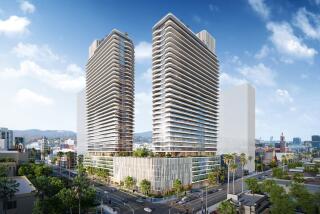Scaled-Down Ambitions
Did the Los Angeles Community Redevelopment Agency promise more than it could deliver in North Hollywood?
A Times story earlier this year used census, property and employment data to quantify what anyone who lives in or has visited the neighborhood knows: After spending 20 years and $117 million, the CRA has not been able to turn North Hollywood around, even compared to similar communities that did not receive redevelopment funds.
The question arises yet again with the news that developer J. Allen Radford has substantially scaled back plans for a commercial and office complex to be built next to the soon-to-open Metro Red Line subway station.
The revised proposal is half the size of the original unveiled two years ago, 22 acres instead of 43. A hotel remains in the plan, as do stores, restaurants, a health club and a movie theater, But gone are the 10 sound stages, for which Radford said he was unable to sign long-term tenants, and the 400 condominiums.
Not all of the changes are bad. Neighborhood residents and Universal City / North Hollywood Chamber of Commerce officials had objected to the original plan’s 20-story office towers. The revised plan has a more campus-like feel, with buildings no taller than five or six stories. Such flexibility regarding neighbors’ wishes is welcome.
And market research had to be taken into account. No one would have wanted to see a complex built only to stand half empty. There are too many vacant buildings already in North Hollywood.
But there’s no denying that losing the sound stages--and the jobs they might have brought to the area--is disappointing. After all, the sound stages were supposed to give North Hollywood a taste of the entertainment business enjoyed by neighboring Burbank.
And not only is housing needed in the ever more crowded East Valley, but clustering condominiums around the subway station would have been the kind of smart development Los Angeles needs if its traffic-choked freeways and streets aren’t going to come to a complete stop. Dense development around transit hubs creates neighborhoods where it’s easier to walk and ride the subway from district to district than drive a car.
Yes, something is better than nothing. And the scaled-down complex, with its hotel, movie theater, shops and restaurants, remains ambitious for North Hollywood. It certainly beats the empty lots and boarded-up buildings near the subway station now.
But it does not deliver all that was promised for the neighborhood. And that is both a shame for North Hollywood and a warning for the City Council as it contemplates creating Los Angeles’ largest and most expensive redevelopment project yet in the northeast San Fernando Valley.
Only by understanding what went wrong in North Hollywood--including whether plans were overly ambitious and unrealistic in the first place--can the city decide how best to proceed in the northeast Valley.
More to Read
Sign up for Essential California
The most important California stories and recommendations in your inbox every morning.
You may occasionally receive promotional content from the Los Angeles Times.










